Geoscience Reference
In-Depth Information
f igu r e 26. (A) Fire scars at the base of a mature Giant Sequoia trunk from the
Sierra Nevada (http://commons.wikimedia.org/wiki/File:Fire_scars_in_sequoia_trunk).
(B) A cut section of a Giant Sequoia trunk from Tuolumne Grove, Yosemite National Park,
California, showing AD dates of i res (photo courtesy of h
omas Swetnam, Laboratory of
Tree-Ring Research, University of Arizona).
the mid-twelt h century, when average temperatures were 1.8°F above the
long-term average and Colorado River l ows were 15 percent below normal.
Increased Wildi res
As conditions grew warmer and drier during the Medieval drought, wildi res
would be expected to be larger and more frequent. Very large and old trees can
provide a long history of past forest i res. Giant Sequoias (
Sequoiandendron
giganteum
), the massive redwoods growing in about seventy-i ve distinct
groves along the mid-elevations of the western Sierra Nevada, are among
the most useful of such living archives. h ese spectacular trees can live up
to 3,200 years or more and can exceed 250 feet in height and 35 feet in diam-
eter. h ey can withstand numerous forest i res throughout their lives, and
these i res leave behind scars (see i gure 26). h omas Swetnam, the current
co-director of the Laboratory of Tree-Ring Research at the University of
Arizona, discovered that these i re scars are visible on their annual growth
rings and can therefore be used to assess the frequency of past i res.
Swetnam and his team sampled Giant Sequoias from i ve groves between
Yosemite National Park and Sequoia National Park, far enough apart that




























